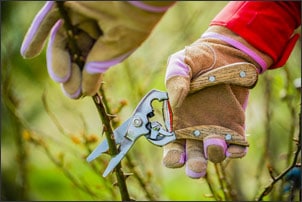
How to Prune Overgrown Rose Bushes

When we moved into our turn-of-the-century home, it was 20 degrees at the beginning of January, and the snow started to fall the next day. It wasn’t until early May that I started to notice the little overgrown garden planted on the south side of the house.
By mid June that year – we had a late spring – I was excited to find that I’d also inherited a turn-of-the-century little rose garden. There were two overgrown rose bushes that produced one flush each of light pink and burgundy roses, respectively. And man! They smelled amazing.
I gathered a handful of each every few days to put in small vases around the house. They didn’t last long – maybe a month from start to finish – but it was well-worth the effort I took to weed that bed to enjoy this herald of summer every year. If I open my kitchen window, I can smell them directly beneath.
What I didn’t know at the time was that I likely had the only heirloom roses left in my neighborhood. Many modern rose varieties bloom for a whole season, but heirloom roses, which are among the most fragrant, bloom just once and then die away until the next year. This makes pruning surprisingly easy.
The Chicago Botanic Garden’s Rose Garden
The Chicago Botanic Garden’s Rose Garden is a landmark to visit if you ever get the chance. It was dedicated in 1985 and has continued to attract visitors in droves every year for over 30 years. They’ve planted their heirloom roses at the back of the Rose Garden and they all burst into glorious, fragrant bloom right on schedule – at the end of May and beginning of June.
This is a great time, in general, to visit Chicago so plan your next visit around the Rose Garden if you can. You will come away with senses full of these ancient and meaningful flowers. Maybe it will inspire you to plant your own rose garden. If you have a neighbor with heirloom varieties, see if you can barter for a cutting.
Tom Soulsby – the senior horticulturist at the Chicago Botanic Garden Rose Garden – tells gardeners to be brave. This was especially relevant to me as I attempted to cut back many years of rose overgrowth without damaging these old and valuable plants. The first thing to remember about pruning, he says, is that you can’t hurt a healthy rose just by pruning it. So gather the right tools, be bold, and go to work.
Tutorial on How to Prune Overgrown Rose Bushes
For most roses, you want to prune just before the plant breaks dormancy after the last frost – so the warmer the climate, the earlier you will need to do it. It will be sometime between January and April in colder climates.
However, if its heirloom varieties you want to prune wait until after they bloom. Roses bear flowers on last year’s wood.
It’s a great idea to visit a rose garden like Chicago Botanic Garden to get a sense of the shape you’re going for, especially if your roses have grown up and out beyond recognition. It’ll also be helpful to see examples of the roses you’re growing in your yard – and you won’t find those heirlooms just anywhere.
Dress the Part
You are going to be cutting and moving thorny canes. You will want to wear long pants, long sleeves, gloves, sturdy shoes, and a pair of goggles. Trust me. It’s better just to be prepared for anything than to have to go in and dress your wounds after five minutes.
Take a Look

You want to first remove any damaged canes. Look for any that seem diseased or pest-ridden. Also, look for canes that have died back in winter.
The next canes you will remove are the older, thicker canes. It takes more energy for the plant to support the big, old ones. Prune those back second and you will get a lot of smaller stems with more buds.
Have the Right Tools
This is one time when price does matter. The wrong tool can crush or rip the canes and open the plant to disease or pests later on. You want a tool that will produce a nice, clean cut without smashing or ripping the fibers of the cane.
Make sure you have pruning shears with two curved blades. Use a well-known manufacturer and buy the best you can afford – it will make all the difference. A pruning saw is a must for large woody canes. Lopping shears (pruners with 12-18’’ handles) will give you leverage for thicker canes. Always cut at a 45 degree angle.
Take Your Time
You may not want to be aggressive. That’s not the same thing as being brave. It can be scary to prune back a beautiful bush that’s been there for 100 plus years. Remember, you can’t hurt it and prune a bit at a time. Most rose bushes – especially the heirloom kind – tolerate pruning very well. They will reward you next year with extra blooms!
After you prune the dead wood, the diseased canes and the thickest and tallest canes, step back – or take a break, and survey what you have left.
What you want is an open center with canes that arch outward. First prune canes that cross through the center.
Then cut back remaining canes. You’re looking for one to two feet from the ground. It may seem a bit aggressive to cut them back so far. However, remember – the plant is expending more energy on those tall canes that it could use on more flowers.
The first year after you prune this aggressively will be a recovery year, so don’t panic if you don’t see many blooms next year. But in the years after that, you’re going to see many more blooms.
Take Away
If you’re lucky enough to have some heirloom roses in your yard, you’re about to enjoy summer’s first fruits. Don’t be afraid to prune them when they’re done. They’ll be happier and healthier in the years to come.



